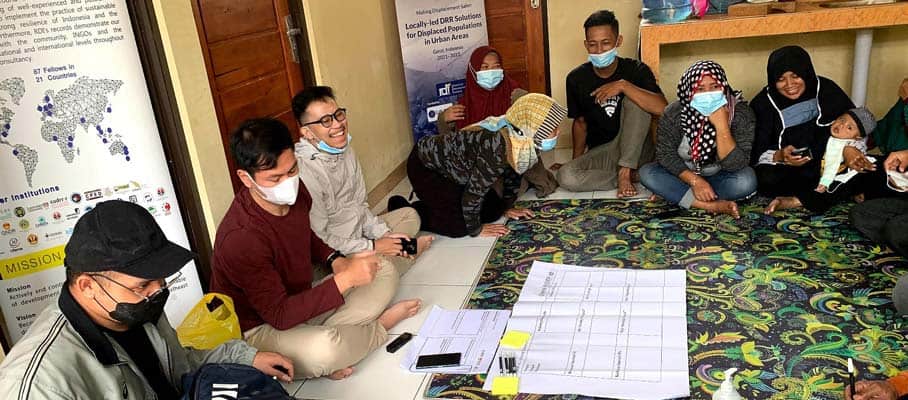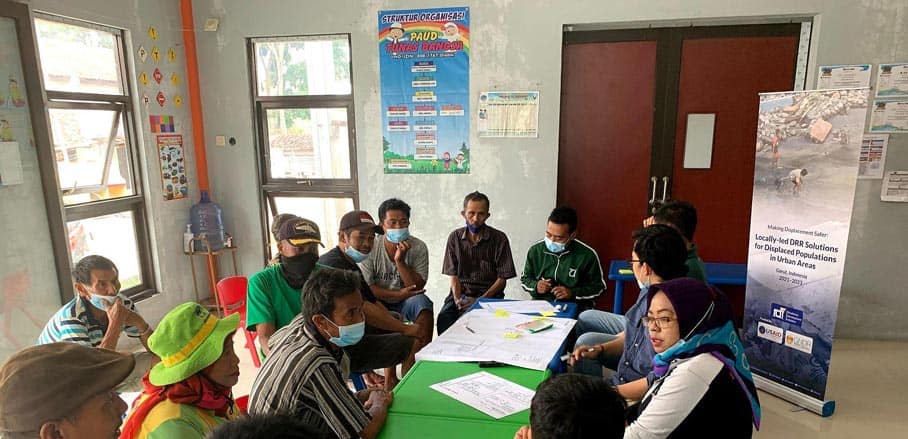The Urban Living Labs Implementation for the Displaced Community in Garut, Indonesia
With disasters forcing people to move, how can host cities ensure adequate living conditions for displaced communities? Saut Sagala, Danang Azhari, and Medhiansyah Putra make a case for Urban Living Labs.
What Risks For Displaced Communities In Indonesian Cities?
Disasters have caused the loss of life and property. The damages often force people to move out and away from their homes, creating displacement. The number of internal displacements due to disasters in Indonesia has constantly increased. In 2020, disasters in Indonesia resulted in 161,000 internally displaced people (IDPs). Most affected communities also end up in informal settlements in urban areas. Thus, IDPs due to disasters need to be in the picture because this situation causes various problems that will roll like snowballs.
For instance, in Garut Regency, the flash flood in September 2016 severely impacted six subdistricts. It resulted in an estimated economic loss of around 28 million USD and the displacement of about 2,525 people. The most affected were communities close to Cimanuk riverbanks, mostly informal settlements bound to high vulnerability that could not be re-inhabited. Later, the local government relocated the people to several locations in the periphery of the Garut Kota Subdistrict. The IDPs, however, were not relocated along with their former community. Instead, they were subdivided into households and placed into new locations. Thus, many problems occur in the new relocation site due to the lack of social cohesion in the displaced community. This calls for a durable solution to solve the problem for the displaced community.
Making Displacement Safer Through Urban Living Labs
Therefore, the Resilience Development Initiative (RDI), along with the Global Network of Civil Society Organisations for Disaster Reduction (GNDR), worked on the “Making Displacement Safer” project to seek locally-led durable solutions to challenges faced by IDPs living in urban areas.
The displaced community in Garut used an Urban Living Labs (ULL) approach. ULL is the approach of gathering all actors, including stakeholders – companies, research institutions, the public sectors – and the community through co-creation for creating innovation. The implementation of ULL helps identify critical stakeholders and formulate outcomes for the displaced population in Garut alongside the community. Therefore, RDI ensures the inclusivity of involvement and insights in finding solutions for the displacement issues in Garut.
Achieving a long-lasting solution for the displaced community issues includes several steps. The first step is a joint exploration to identify the community’s challenges and needs. The findings indicate that the displaced communities cannot sustain their livelihood in the relocation sites. Therefore, the following steps focus on creating the solution for the community to be more resilient and sustain their livelihood in the relocation site.

© Resilience Development Initiative (RDI)
Urban Living Labs For Social And Economic Development of Displaced Communities
The next step is co-creation, which encourages the exploration of creative initiatives to be implemented in the displaced communities. This step developed a durable solution, such as creating cooperative community establishment in a form of community cooperative enterprise (Koperasi) at the relocation sites. Therefore, capacity building is done to establish cooperative enterprise and develop micro, small, and medium enterprise (MSME).
The cooperative enterprise uses the principles of “based on the community, for the community, and by the community” and it was deemed appropriate as a long-lasting solution to be implemented further. Considering most displaced communities have knowledge and resources limits to develop their business, it can solve community-based economic resilience. Several local products can be designed, such as convection, birdcage, aquarium craft, snacks, and handicrafts. In addition, the cooperative enterprise will also provide a better foundation for MSME in the relocation site and will generate more in the future. Moreover, the modal capital generated from the cooperative enterprise could be used to implement other initiatives in the future.
Furthermore, the implementation phase focuses on progressive and open approaches to execute a solution that has been chosen. The solution includes three crucial points for the displaced community: community self-reliance post-disaster, supporting community business, and increasing the livelihood in relocation areas. The community and stakeholders have cooperated with RDI to achieve the solution. This collaboration has demonstrated how a safe space to discuss contributes to the successful solution for the displacement issue. Furthermore, the collaboration is also committed to the evaluation and monitoring process of ULL to ensure a sustainable solution.
ULL has shown convincing results in achieving durable solutions. However, in every implementation of a new approach, there will be barriers that must be passed. In this case, the main problem is providing a safe space to gather inputs from everyone involved. As the ULL approach is sustainable, a better understanding and re-elaboration are required. Ensuring the results come from a mutual agreement requires iteration and verification, which takes time and is quite a complicated problem. Therefore, an understanding and frequent engagement with the community and relevant stakeholders is pivotal to delivering the expected results.
